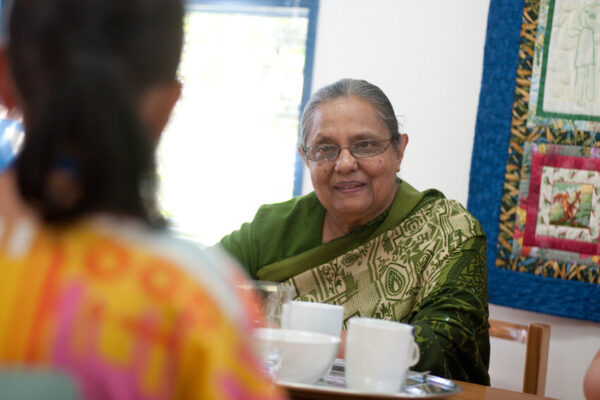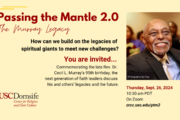This article was originally published in Religion Unplugged, with the support of CRCC’s global project on engaged spirituality.
BERLIN— There is a temptation when you meet Ela Gandhi to assume her soft, fluttering voice, attentive nature and reserved demeanor encapsulate her personality as a whole.
On that, said her friend and biographer Susan Easterbrooks, you would be wrong.
“Behind that sweet demeanor,” she said, “is the heart of a lion. It’s a gentle heart, it’s a respectful heart, but it’s also a no-holds-barred kind of heart.”
Beyond being one of Mahatma Gandhi’s — or Ghandiji’s — granddaughters, Ela Gandhi has become a symbol of social justice in her own right, living a life of quiet — and not so quiet — resistance over the last 80 years. A new book by Easterbooks, “My Time with Ela Gandhi,” chronicles the lessons learned and stories told by Gandhi throughout their friendship.
Growing up in Phoenix, one of the oldest Indian settlements in South Africa, Gandhi later went on to serve as a social worker engaged in non-violent protests and activism, fighting on behalf of the oppressed. Along the way to helping South Africa transition to a post-Apartheid state by sitting on the Transitional Executive Committee in the South African government and as a member of South Africa’s Parliament (1994-2004), Gandhi faced house arrest for nine years and lost her son, who was killed in the struggle for justice.
Now retired, Gandhi remains committed to social justice and interreligious harmony. She founded and still chairs the Gandhi Development Trust, is a member of South Africa’s Religious Affairs Committee and works with international organizations, including Religions for Peace.
Devoted to the cause of peace, fighting injustice and crossing political and religious boundaries to do so, this is the story of Gandhi’s engaged spirituality over the long haul.
From the streets of Phoenix to the halls of parliament
Most people who know Phoenix, South Africa today know it as where the infamous Ghandiji’s philosophy of passive resistance developed in embryonic form, before he employed it in India to free his homeland from British colonial rule.
Ela Gandhi simply knows it as “home.”
It was on Phoenix’s rolling green hills and meandering dirt streets that Gandhi grew up running next door to borrow ghee (clarified butter) from the neighbors, picking vegetables in the shared market gardens, joining in communal prayers and hymns or sharing parcels of homemade sweets for Christmas, Diwali or Eid.
Following Gandhiji’s principle of self-sufficiency, Gandhi’s parents Manilal and Sushila — married in India in 1927 — ran the Phoenix settlement’s printing press thereafter. They built the brick home she grew up in by hand and tended to the mango and lemon trees that her grandfather himself planted.
There, Gandhi learned “the confluence of spirituality that makes up Gandhian values.” Values, she said, that guided her throughout her life.
“Our neighbors accepted what we were doing, and we accepted what they were doing,” said Gandhi. “We would have a Christian prayer, a Muslim prayer or Hindu prayer. People spoke different languages — spiritual and literal.”
Gandhi gleaned from multiple traditions, like satyagraha service (non-violent resistance), theologies of liberation and practices of self-discipline.
Her education started in her parents’ brick home before her mother started a racially-integrated school at the Gandhi house for about 200 children when Ela was 8 or 9. Not too long after, an inspector from the Apartheid government warned Sushila not to educate Black children. Under Apartheid, the government passed a series of laws enforcing separate and unequal education for each of South Africa’s racially classified groups: White, Black, Colored (mixed race) and Indian.
It was then that another kind of education began for Gandhi. “This is where I first became aware of racial oppression,” she said.
By age 12, she was marching with her father as part of the Defiance Campaign — a large non-violent resistance campaign from 1950-1952, featuring boycotts, strikes and civil disobedience. Gandhi went to the Brook Street library, where “Coloureds” were not allowed.
She went in anyway.
Then, she went on to university and studied for two bachelor’s degrees at Natal University. As a college student Gandhi said she learned a lot leaving the Phoenix settlement and stepping out of her comfort zone.
“In a way, my parents protected me from Apartheid, but then I get to university and they have separate buildings, one for Whites, one for others,” she said. “It’s the same university, but you can’t access all the facilities simply because you are not White. It was then that I started to understand the extent of oppression and it made me angry.”
She channeled her anger into “more positive behavior,” she said, taking part in placard demonstrations against unequal access at the university.
As a social worker in the Inanda District of Durban after school, Gandhi saw the “absolute poverty” of her community and her righteous rage was rekindled. So, she not only sought to ameliorate the day-to-day suffering of people in her community, she said, but also sought to fight the system that kept them down.
Her reputation as an agitator for justice became so well known that soon, Apartheid authorities took notice. For taking in those who had been arrested by the authorities and organizing alternative labor societies when unions were banned, Gandhi was put under house arrest for nearly ten years along with her former husband, Mewa Ramgobin.
Prevented from going to meetings, barred from leaving her home on weekends and under curfew from 7 p.m. to 7 a.m. every day, Gandhi worked underground and — she said with a bit of twinkle in her eye — “broke the banning order and house arrest many times.”
“We started to organize politically,” Gandhi said. “It wasn’t a turning point, but more of a natural progression from the Gandhian values we were living.”
She served as the executive of the Natal Organization of Women and became vice president of the Natal Indian Congress (NIC). Gandhi then became involved in the anti-Apartheid United Democratic Front (UDF) — a multi-racial coalition of civic, religious, student and worker organizations — in the 1980s.
It was during this politically active time that one of her sons was killed in the struggle against Apartheid, shot in his home by an unknown assassin in 1993.
Amidst the pain and the sadness, Gandhi also felt anger over the loss of her son. In her darkest times, she would draw on the repertoire of multi-faith prayers she learned as a child.
“It helps me controlling the anger, it’s some sort of anchor, to help me build resilience,” she said. “It’s helped me get over the pain, even though you never really get over losing a child.”
Through prayer and the encouragement of others, Gandhi once again channeled her anger into activism, sitting on the Transitional Executive Committee and serving in South Africa’s first democratically-elected parliament, focusing on welfare programs and support for single mothers.
Legacy and lessons learned
During her life, Gandhi worked hand-in-hand with some of the most famous figures of the anti-Apartheid movement, from Nelson Mandela and Archbishop Desmond Tutu to Mama Sisilu and Steve Biko.
“There were some blockbuster events in my life, you know,” she said, “but I’ve never been one for glitzy events. I would rather hide away in some corner.”
Oddly enough, Gandhi doesn’t have much evidence of these friendships and interactions other than her memories and the history books written about them.
“I don’t even have a single picture of me with Mandela,” she said. “I just don’t think of taking photographs, because they don’t mean as much to me as interaction with people, learning from other people through conversations.”
This, said Easterbooks, is a testament to Gandhi’s effusive humility and the desire to deflect attention to those she interacts with.
When Easterbrooks first traveled to South Africa as part of a partnership between her U.S. university and the Durban University of Technology, little did she know that it would spark a long-term friendship between her and Gandhi.
Now, the stories she heard and the lessons she learned from Gandhi along the way are distilled in her new book “My Time with Ela Gandhi”.
Reflecting on her time with Gandhi, she said, “my editor says to not use the word ‘humble.’ But she’s just very humbling. As soon as you meet her and talk to her, the next thing you know, she has taken your request to the next level on your behalf.”
Easterbrooks said Gandhi left a profound influence on her, particularly when it comes to her “engaged spirituality.”
“Gandhi’s life shows us that in constructive action, you can turn people from their personal frustrations and help them see a broader, higher perspective,” said Easterbrooks.
She said that no matter how many times Gandhi was banned, barred or thrown into jail, she continued to gather women around her struggling with their own issues — whether it was the cost of housing or not being able to sit on certain benches because of Apartheid’s unjust laws.
She inspired people not only to protest, but to consider how “you can sit back and complain about things, or you can take action and by your actions demonstrate a better way of being. She helped people create a better reality. And in creating the better reality, they felt more empowered, and in feeling more empowered, they could continue to create more,” said Easterbrooks.
Gandhi isn’t done yet. Amidst the global unrest and upheaval of the COVID-19 pandemic, she continues to work toward sustainable local activism and inclusive intercultural and interracial justice.
“In my mind, I’m still an activist,” Gandhi said. And so, as she often did throughout her life, Gandhi channels grand goals into her local, everyday life and with the people around her that need her help the most.
“Before the pandemic, I used to travel back to Phoenix often,” she said, “but now staying at home, I am saving money.” Instead of using that money for herself, Gandhi has been buying groceries for those who cannot afford them or funneling the extra funds to causes she believes in.
She shared this not to draw attention what she is doing, she said, but to inspire others “to change things to make the world more secure.”
In a time of upheaval and uncertainty, Gandhi said that pursuing equity and generosity for others might be a way through the chaos. It was, she said, always the case for her over the course of an active and often tumultuous life.
Thinking back to her first days working as a social worker in Durban, she said it was always the “grassroots people” that sustained her.
Today, it’s no different.
“When I go out and work in the community and try to make their lives better. That’s what sustains me,” she said. “I’m not doing many things, but the little that I can do — even if it’s for a few people — it makes me happy.”
Read the article on religionunplugged.com.
Ken Chitwood is an affiliate with the USC Center for Religion and Civic Culture.









